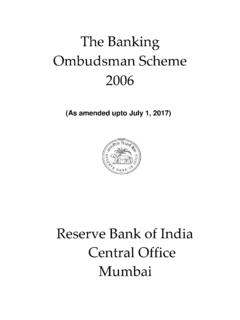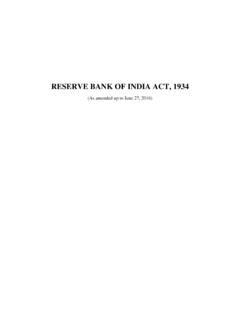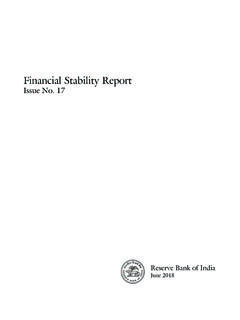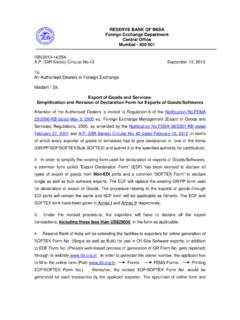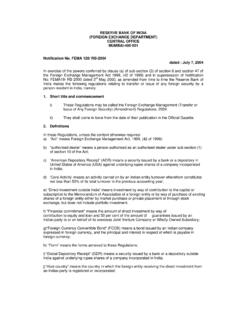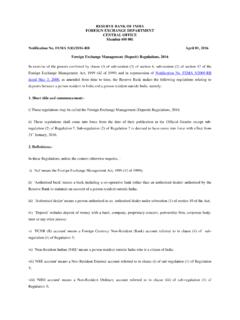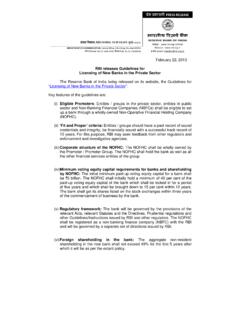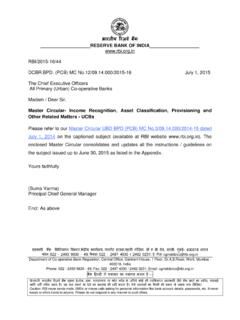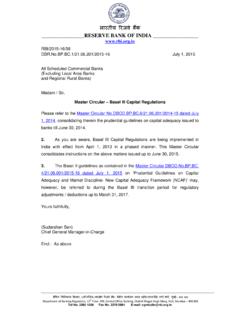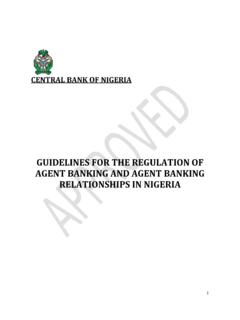Transcription of RESERVE BANK OF INDIA DEPARTMENT OF NON-BANKING …
1 RESERVE BANK OF INDIA DEPARTMENT OF NON-BANKING REGULATION CENTRAL OFFICE, CENTRE I, WORLD TRADE CENTRE CUFFE PARADE, COLABA MUMBAI - 400 005. RBI/DNBR/2016-17/44 Master Direction September 01, 2016 (Updated as on February 17, 2020*) (Updated as on November 22, 2019*) (Updated as on August 02, 2019*) (Updated as on February 22, 2019*) (Updated as on May 31, 2018*) (Updated as on February 23, 2018*) (Updated as on November 09, 2017*)
2 (Updated as on March 09, 2017*) (Updated as on March 02, 2017*) (Updated as on February 02, 2017*) (Updated as on October 17, 2016*) Master Direction - NON-BANKING Financial Company Non-Systemically Important Non-Deposit taking Company ( RESERVE Bank) Directions, 2016 The RESERVE Bank of INDIA (the Bank), having considered it necessary in the public interest, and being satisfied that, for the purpose of enabling the Bank to regulate the financial system to the advantage of the country and to prevent the affairs of any Non-Systemically Important Non-Deposit taking NON-BANKING Financial Company (NBFC-ND) from being conducted in a manner detrimental to the interest of investors or in any manner prejudicial to the interest of such NBFCs, and in exercise of the powers conferred under sections 45JA, 45L and 45M of the RESERVE Bank of INDIA Act, 1934 (Act 2 of 1934) and section 6 of the Factoring Regulation Act, 2011, hereby issues to every NBFC-ND, in supersession of the Notification DG(VL)
3 -2007 dated February 22, 2007, Notification dated February 12, 2010, Notification CGM(US)2011 dated December 02, 2011, Notification (US)-2012 dated July 23, 2012 and Notification (CDS)-2015 dated March 27, 2015 the NON-BANKING Financial Company Non-Systemically Important Non-Deposit taking ( RESERVE Bank) Directions, 2016 (the Directions) hereinafter specified. * Since this Master Direction has been significantly amended, it has been replaced rather than showing the changes in track mode for reader convenience. 2 Index Section I : Introduction Chapter I Preliminary Chapter II Definition Chapter III Registration Section II : Prudential Issues Chapter IV Prudential regulations Chapter V Fair Practice Code Chapter VI Specific Directions to NBFC- Factor Chapter VII Specific Directions on IFC-NBFC Chapter VIII Specific Direction on NBFC-MFI Section III : Governance Issues Chapter IX Acquisition/Transfer of Control Section IV.
4 Miscellaneous Issues Chapter X - Opening of Branch/Subsidiary/Joint Venture/Representative Office or Undertaking Investment Abroad by NBFCs Chapter XI Miscellaneous Instructions Chapter XII Reporting Requirements Chapter XIII Interpretations Chapter XIV Repeal Annex Annex I Timeline for Government NBFCs Annex II Guidelines on Liquidity Risk Management Framework Annex III - Schedule to the Balance Sheet of a NBFC Annex IV - Data on Pledged Securities Annex V - Guidelines for Licensing of New Banks in the Private Sector Definitions Annex VI - Norms on Restructuring of Advances by NBFC Annex VII - Flexible Structuring of Long Term Project Loans to Infrastructure and Core Industries Annex VIII - Ombudsman Scheme for NON-BANKING Financial Companies, 2018 - Nodal Officer/Principal Nodal Officer Annex IX - Calculation of CRAR after making provisions on AP portfolio Annex X - Self Regulatory Organization (SRO) for NBFC-MFIs Criteria for Recognition Annex XI- Information about the proposed promoters/directors/shareholders of the company Annex XII - Guidelines for Entry of NBFCs into Insurance Annex XIII - Guidelines on issue of Co-Branded Credit Cards Annex XIV - Guidelines on Distribution of Mutual Fund Products by NBFCs Annex XV- Guidelines for Credit Default Swaps - NBFCs as users Annex XVI - Guidelines on Securitisation Transactions Annex XVII - Guidelines on Private Placement of NCDs Annex XVIII - Early Recognition of Financial Distress, Prompt Steps for Resolution and Fair Recovery for Lenders.
5 Framework for Revitalising Distressed Assets in the Economy Annex XIX Directions on Managing Risks and Code of Conduct in Outsourcing of Financial Services by NBFCs 3 Section I : Introduction Chapter I Preliminary 1. Short Title and Commencement of the Directions. (1) These Directions shall be called the NON-BANKING Financial Company Non-Systemically Important Non-Deposit taking Company ( RESERVE Bank) Directions, 2016 (2) These Directions shall come into force with immediate effect. 2. Applicability (1) The provisions of the Directions shall apply to the following: (i) every NON-BANKING financial company not accepting / holding public deposits which is not systemically important (as defined in paragraph3 (xxix) of the Directions; (ii) every NBFC-Factor registered with the Bank under section 3 of the Factoring Regulation Act, 2011 and having an asset size of below 500 crore; (iii) every NON-BANKING Finance Company Micro Finance Institution (NBFC-MFI) registered with the Bank under the provisions of RBI Act, 1934 and having an asset size of below 500 crore.)
6 (iv) every NON-BANKING Finance Company - Infrastructure Finance Company (NBFC-IFC) registered with the Bank under the provisions of RBI Act, 1934 and having an asset size of below 500 crore. (2) The Category of NBFCs as mentioned in points (i) to (iv) above are hereinafter referred to as applicable NBFCs , for the purpose of these Directions. Specific directions applicable to specific categories of NBFCs registered as NBFC-Factors, NBFC-IFC and NBFC-MFIs are as provided for under respective Chapters in these Directions. (3) These Directions, shall apply to a NON-BANKING financial company being a Government company as defined under clause (45) of section 2 of the Companies Act, 2013 (Act 18 of 2013).
7 The directions relating to prudential regulation, 4 acceptance of public deposits, corporate governance, conduct of business regulations and statutory provisions etc. shall, however, be followed by the government NBFCs as per the timeline provided in Annex I. Government NBFCs that are already complying with the prudential regulation as per the road map submitted by them shall continue to follow the (4) (i) The Directions under Chapter IV, paragraph 70 and Chapter V shall not apply to those applicable NBFCs who have not accessed any public funds and do not have any customer interface. (ii) Applicable NBFCs accessing public funds but having no customer interface are exempt from the applicability of paragraph 70 and Chapter V of the directions.
8 (iii) Applicable NBFCs having customer interface but not accessing public funds are exempt from the applicability of Chapter IV of the directions. (5) These Directions consolidate the regulations as issued by DEPARTMENT of NON-BANKING Regulation, RESERVE Bank of INDIA . However, any other Directions/guidelines issued by any other DEPARTMENT of the Bank, as applicable to an applicable NBFC shall be adhered to by it. Chapter II Definitions 3. For the purpose of these Directions, unless the context otherwise requires: (i) "Act" means the RESERVE Bank of INDIA Act, 1934; (ii) "Bank" means the RESERVE Bank of INDIA constituted under section 3of the RESERVE Bank of INDIA Act, 1934 (iii) break up value means the equity capital and reserves as reduced by intangible assets and revaluation reserves, divided by the number of equity shares of the investee company; (iv) carrying cost means book value of the assets and interest accrued thereon but not received.
9 1 Government Companies were advised vide 86 dated December 12, 2006 to submit to the RESERVE Bank [ DEPARTMENT of Non banking Supervision (DNBS)] a road map for compliance with the various elements of the NBFC regulations , in consultation with the Government.] 5 (v) Company means a company registered under section 3 of the Companies Act, 1956 or a corresponding provision under Companies Act, 2013; (vi) companies in the group , shall mean an arrangement involving two or more entities related to each other through any of the following relationships: Subsidiary parent (defined in terms of AS 21), Joint venture (defined in terms of AS 27), Associate (defined in terms of AS 23), Promoter-promotee (as provided in the SEBI (Acquisition of Shares and Takeover) regulations , 1997) for listed companies, a related party (defined in terms of AS 18), Common brand name, and investment in equity shares of 20% and above.
10 (vii) Conduct of business regulations means the directions issued by the Bank from time to time on Fair Practices Code and Know Your Customer. (viii) "control" shall have the same meaning as is assigned to it under clause (e) of sub-regulation (1) of regulation 2 of Securities and Exchange Board of INDIA (Substantial Acquisition of Shares and Takeovers) regulations , 2011. (ix) current investment means an investment which is by its nature readily realisable and is intended to be held for not more than one year from the date on which such investment is made; (x) customer interface means interaction between the NBFC and its customers while carrying on its business. (xi) earning value means the value of an equity share computed by taking the average of profits after tax as reduced by the preference dividend and adjusted for extra-ordinary and non-recurring items, for the immediately preceding three years and further divided by the number of equity shares of the investee company and capitalised at the following rate: (a) in case of predominantly manufacturing company, eight per cent; (b) in case of predominantly trading company, ten per cent; and (c) in case of any other company, including NON-BANKING financial company, twelve per cent; Note: If, an investee company is a loss making company, the earning value will be taken at zero.
